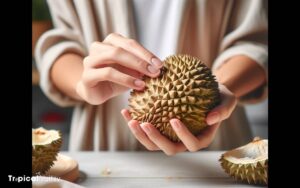Why Do People Hate Durian? Behind the Controversy!
The dislike for durian fruit is primarily due to its strong, pungent smell, which many compare to rotting onions or sewage. This aroma is so intense that durian is banned in some public places.
The fruit’s texture, resembling creamy custard, is also a common deterrent, along with its unique taste profile that combines sweet and savory notes.
Psychological factors, cultural biases, and initial negative experiences can reinforce the aversion. Additionally, health concerns and limited access to fresh durian contribute to its polarizing status.
Reasons for the aversion to durian fruit include:
Despite its nutritional benefits, the durian fruit’s challenging characteristics can turn many away from trying it.
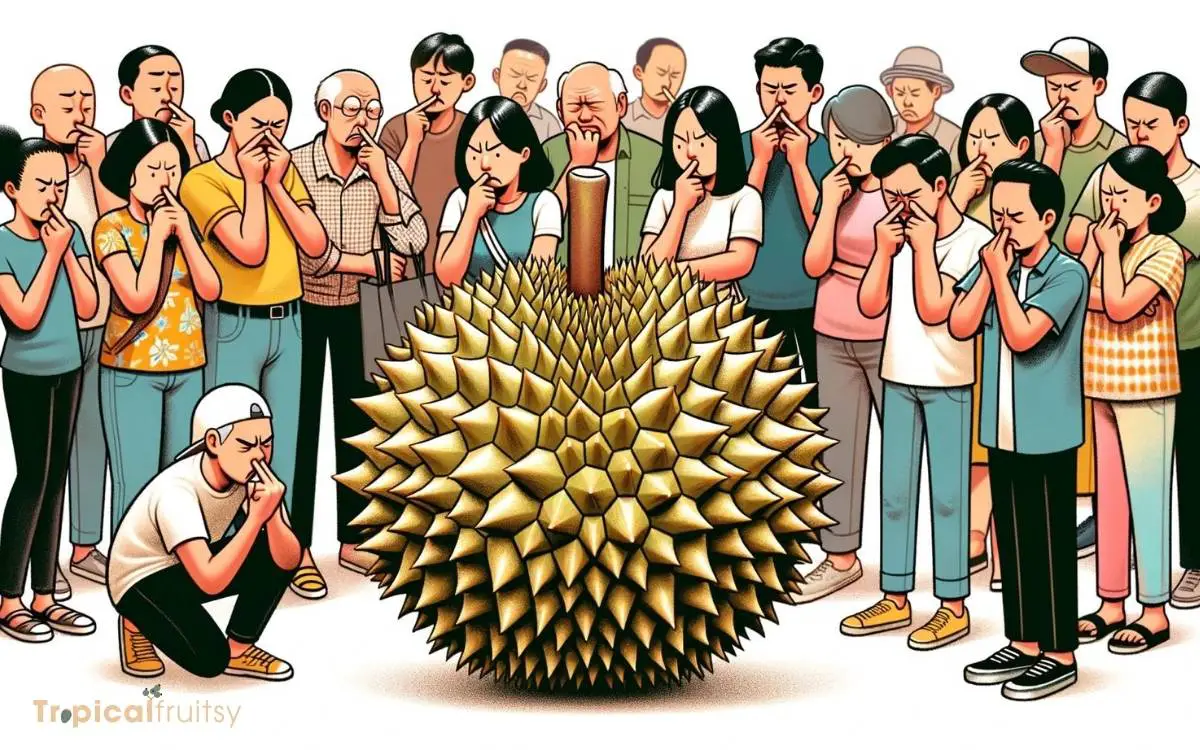
Key Takeaway
Factors Influencing Durian Perception
| Factor | Description | Potential Impact on Perception |
|---|---|---|
| Smell | Compared to onions, turpentine, and sewage. | Strong negative reaction |
| Texture | Creamy, custard-like flesh. | Disliked by those preferring firmer textures |
| Taste | A unique combination of sweet and savory flavors. | Confusing for newcomers |
| Psychological | Influenced by unconventional characteristics. | Leads to strong aversion |
| Cultural | Affected by sociocultural influences and media portrayals. | Shapes negative perceptions |
| Initial Experience | First encounters can leave a lasting impression. | Can cause long-term dislike |
| Health and Freshness | Concerns about health effects and desire for freshness. | Limits willingness to consume durian |
The Infamous Aroma

Investigating the notorious aroma of durian fruit reveals a complex interplay of volatile compounds that elicit strong reactions, often perceived as unpleasant, by many individuals.
The scent profile of durian is not merely a single note but a symphony of biochemical elements, including esters, ketones, and alcohols, which in combination yield its characteristic smell.
Scientific analysis has likened these odoriferous components to various familiar scents, ranging from rotten onions to turpentine and even raw sewage.
This multidisciplinary approach, integrating chemistry, genetics, and sensory science, helps to contextualize the divisive nature of durian’s aroma.
Understanding the molecular basis for this reaction informs not only food science but also provides insight into human olfactory responses and cultural food preferences.
Texture Challenges

Beyond its pungent aroma, durian’s unique texture—often compared to a rich custard interspersed with fibrous segments—presents another hurdle for many consumers, challenging their textural preferences and contributing to the fruit’s polarizing reception.
This textural complexity derives from a combination of creamy pulp and stringy fibers that create a sensory contradiction not commonly found in other fruits.
From a psychological standpoint, a food’s texture plays a crucial role in palatability and acceptability. An aversion to certain textures, a phenomenon known as food tactility, can be as influential as taste or smell.
Nutritionally, while durian is a rich source of energy and vitamins, its texture may discourage consumption, thus denying some individuals the fruit’s health benefits.
Consequently, durian’s texture is a multifaceted barrier, intertwining cultural, psychological, and nutritional dimensions in shaping its global reputation.
Taste Complexity

The durian’s taste complexity is often as polarizing as its odor, with a profile that straddles the extremes of sweet and pungent, challenging palates accustomed to more homogeneous flavors.
This spectrum of flavor within a single fruit reflects not only a unique biochemical composition but also the intricate interplay between human sensory perception and cultural gastronomy.
Consequently, durian’s demand on the palate as an acquired taste may lead to its rejection or adoration, a testament to the multifaceted relationship between taste and individual as well as collective experience.
Sweet yet Pungent
Within the divisive realm of durian flavor, the fruit’s enigmatic taste profile is characterized by a perplexing blend of sweet richness and sharp pungency.
The juxtaposition of these flavors can confuse the palate, leading to a polarized audience: those who savor its complexity and others who reject it outright.
This dichotomy is not merely a matter of individual preference but a confluence of psychological, cultural, and biochemical factors.
| Aspect | Description |
|---|---|
| Sweetness | Indicative of the fruit’s high sugar content. |
| Creaminess | Likened to a rich custard or almond-like texture. |
| Pungency | A result of volatile sulfur compounds. |
| Aromaticity | Complex bouquet ranging from floral to skunky. |
Analyzing durian’s flavor entails considering its multifaceted sensory impact, where culinary science meets cultural perception, influencing acceptance or aversion to this controversial fruit.
Flavor Profile Spectrum
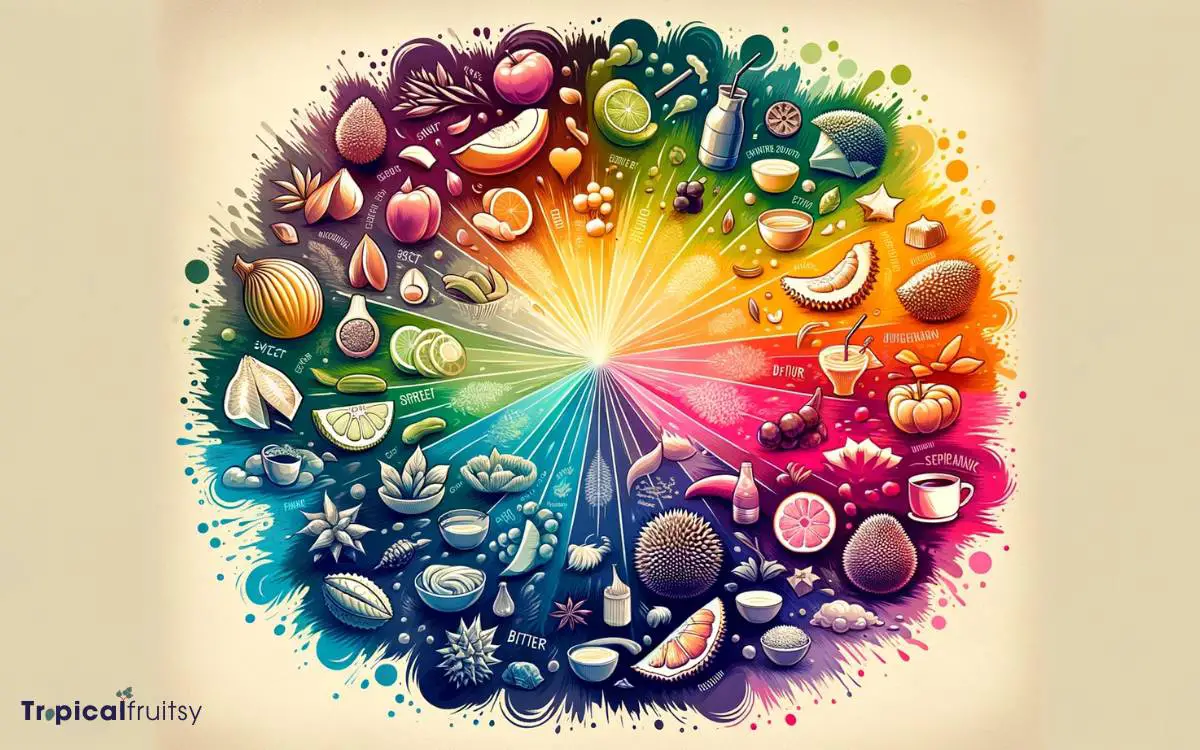
Durian’s flavor profile spectrum is an intricate tapestry of tastes, intertwining sweetness, creaminess, and a notorious pungency that leaves no taste bud untouched.
This complexity is not merely a culinary curiosity but a phenomenon inviting analysis from a biochemical perspective.
The fruit’s unique amalgam of volatile compounds results in a multifaceted sensory experience, which can be both beguiling and off-putting.
Culturally, durian is revered in some societies, where its robust flavor is synonymous with indulgence, while in others, its potent aroma is met with aversion.
The psychological aspect of taste perception also plays a role, as individuals’ flavor thresholds and past experiences with similar taste profiles can influence their reaction to durian.
Understanding this spectrum requires a multidisciplinary approach, encompassing gastronomy, chemistry, and psychology.
Acquired Taste Challenge
Despite its revered status in certain cultures, durian often presents an acquired taste challenge due to its complex flavor profile that can overwhelm uninitiated palates.
The fruit’s sensory paradox combines pungent aromas with a custard-like texture and a taste that vacillates between sweet and savory. This multifaceted experience can confound taste receptors, leading to polarized reactions.
The complexity of durian’s flavor prompts a deeper analysis:
- Cultural Shock: The stark difference from familiar fruits can lead to an emotional dissonance for first-time tasters.
- Sensory Overload: The intensity of durian’s aroma and flavor can invoke a visceral, instinctive aversion.
- Psychological Anticipation: Preconceived notions about durian may prime individuals for negative experiences, influencing their taste perception.
Understanding these elements can foster empathy for those who struggle to appreciate durian’s unique taste.
Psychological Reactions

Revulsion is one common psychological reaction many individuals experience when first encountering the pungent aroma of durian fruit.
The scent, often compared to rotten onions or sewage, can trigger a visceral response, deeply rooted in the evolutionary aversion to potentially hazardous foods.
This instinctual reaction is a defense mechanism; a way our ancestors avoided illness. However, cultural perceptions and personal experiences greatly influence psychological reactions to foods like durian.
Exposure and social context can modulate the initial repulsion, potentially transforming disgust into a palatable or even pleasurable experience.
| Psychological Factor | Influence on Perception of Durian |
|---|---|
| Evolutionary Aversion | Innate defense against spoilage |
| Cultural Conditioning | Can alter the initial revulsion |
| Exposure and Social Context | May shift from disgust to delight |
This multidisciplinary analysis bridges psychology, anthropology, and biology to understand the complexities of human taste perception and the divisive nature of durian.
Sociocultural Influences

Understanding the sociocultural influences on food preferences, exposure to durian within certain cultures can lead to an appreciation of its unique flavor and significance in social rituals.
This appreciation often stems from:
- Cultural Heritage: Durian is ingrained in the culinary traditions of Southeast Asia, symbolizing both prosperity and communal ties.
- Festive Celebrations: Its consumption during festivals and family gatherings fosters a shared sensory experience that reinforces social bonds.
- Rite of Passage: Trying durian can be seen as a cultural milestone, connecting individuals to local customs and narratives.
From an analytical and multidisciplinary perspective, these factors collectively construct a positive emotional framework around durian, which might otherwise be maligned for its pungent aroma and taste.
This deeply rooted cultural affinity sets the stage for clashes with outsiders’ perspectives, paving the way for negative first impressions that we will now explore.
Negative First Impressions

Many individuals’ aversion to durian is rooted in their initial encounter with the fruit’s overpowering odor, often described as a stark contrast to more commonly accepted fruit fragrances.
This visceral reaction can be understood through a multidisciplinary lens, considering the psychological, cultural, and biological aspects of sensory perception.
| Aspect | Description | Impact on Perception |
|---|---|---|
| Psychological | First impressions are enduring | Creates bias against durian |
| Cultural | Familiarity with certain scents | Frames durian as unpleasant |
| Biological | Sensitivity to certain compounds | Triggers adverse reaction |
These factors culminate in a powerful negative first impression that often deters subsequent encounters with durian, despite potential culinary delights.
This sensory clash plays a considerable role in the fruit’s global reputation. Moving forward, the impact of durian on health and dietary concerns further shapes its controversial standing.
Health and Dietary Concerns
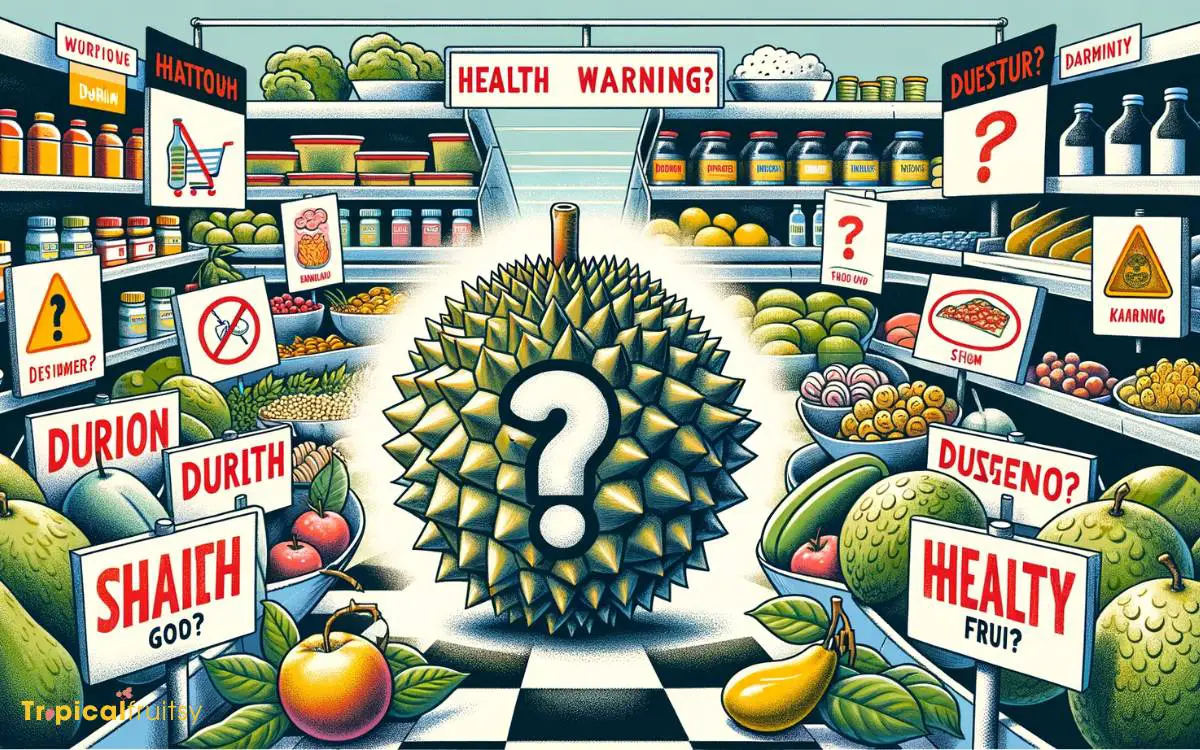
While durian’s unique aroma may polarize consumers, underlying health and dietary concerns also contribute to its contentious reputation.
Assessments of durian’s nutritional content reveal a complex interplay of beneficial vitamins and minerals, juxtaposed with considerable caloric density.
Moreover, the potential allergenic properties of durian, coupled with its reported effects on digestion, necessitate a careful evaluation of its suitability for individual consumption within diverse dietary frameworks.
Allergy Risk Factor
Addressing health and dietary concerns, the potential for allergic reactions to durian is a significant factor contributing to aversion toward the fruit. While not widespread, durian allergies can provoke serious health risks.
An analytical approach to the multidisciplinary implications of such allergies reveals the following:
- Unexpected Reactions: Individuals may unknowingly possess a sensitivity to durian, risking anaphylactic shock, a life-threatening condition requiring immediate medical attention.
- Cross-Reactivity: Those with allergies to other foods like latex or birch pollen might experience a cross-reactive response due to similar allergenic proteins.
- Dietary Restrictions: Health-conscious individuals with a history of food allergies might avoid durian preemptively, fearing potential adverse effects on their well-being.
Understanding these concerns is crucial for appreciating the trepidation some individuals feel towards incorporating durian into their diets.
Nutritional Content Analysis

Despite its divisive reputation, durian fruit offers a complex nutritional profile that is rich in vitamins, minerals, and dietary fiber, potentially benefiting those who can tolerate its distinctive taste and aroma.
A thorough examination reveals that durian is notably high in vitamin C, which is essential for immune function, and B vitamins, particularly thiamin and riboflavin, which are crucial for energy metabolism.
It also provides potassium, which plays a vital role in maintaining proper heart function and blood pressure.
The presence of dietary fiber in durian supports gastrointestinal health, but its high caloric content and natural sugars must be considered within the context of a balanced diet.
As healthful as these components may be, their implications on digestion warrant further discussion, leading us to consider durian’s digestive impact considerations.
Digestive Impact Considerations
How does the high fiber and sugar content of durian influence digestive health and overall dietary considerations?
The fibrous nature of durian can be a double-edged sword, promoting healthy bowel movements and potentially aiding in the prevention of constipation. However, it can also lead to uncomfortable bloating and gas for some individuals.
The fruit’s high sugar content, while a source of quick energy, can pose challenges for those with diabetes or those watching their caloric intake for weight management purposes.
- Enhanced Digestion: The fiber in durian supports a robust digestive system, but its excessive intake can strain the gastrointestinal tract.
- Blood Sugar Spikes: Its natural sugars can cause sharp fluctuations in blood sugar levels, requiring careful consumption.
- Nutrient-Rich Yet Calorically Dense: Durian offers a wealth of nutrients, though its high caloric content demands moderation in diet planning.
Availability and Freshness

The availability and freshness of durian fruit can significantly influence individuals’ perceptions and acceptance, as consuming durian past its optimal ripeness often leads to an intensified, disagreeable odor and taste.
Geographic and seasonal factors dictate the accessibility of fresh durian, making it a rare delicacy in non-native regions.
The fruit’s notorious aroma is exacerbated when it is not fresh, which can be a common occurrence due to the complexities of international shipping.
A multidisciplinary analysis, from the agricultural logistics to sensory science, reveals that the time-sensitive nature of durian consumption is a critical determinant in its reception.
Ensuring optimal freshness is pivotal in mitigating negative reactions and requires a sophisticated understanding of supply chain management.
This interplay between availability and public opinion segues into the influence that media and public perception have on the durian’s notoriety.
Media and Public Perception
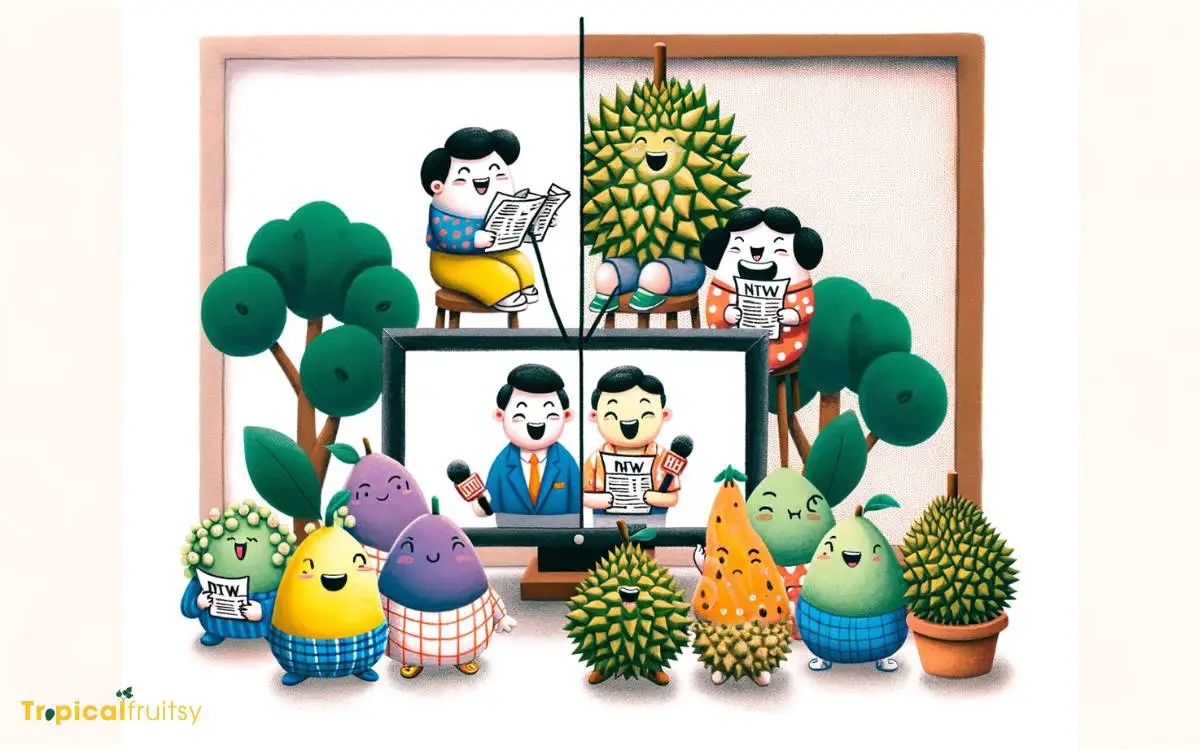
Media portrayals have significantly shaped public opinion about durian, often highlighting the fruit’s divisive scent to the detriment of its culinary potential.
This focus on the negative aspects of durian’s aroma has overshadowed its rich taste and cultural significance in parts of Southeast Asia.
The narrative surrounding durian is not just about sensory perception but also about cultural identity and the dynamics of exoticism in global food discourse.
- The Intensity: Media often sensationalize the pungent smell, likening it to rotten onions or spoiled meat, which can trigger disgust.
- The Exoticization: Exaggerating durian’s foreignness, reports may portray it as an oddity, undermining its esteemed status in its native regions.
- The Neglect: Culinary appreciation for durian’s creamy texture and sweet, almond-like flavor is frequently overshadowed by the fixation on its odor.
In analyzing the media’s role, it becomes clear that the portrayal of durian is not merely a reflection of its inherent qualities but a complex interplay of cultural attitudes and sensationalism.
Conclusion
The polarizing reception of durian stems from its potent aroma, unique texture, complex taste, psychological responses it provokes, sociocultural associations, often negative initial encounters, health considerations, issues with availability and freshness, and the influence of media narratives.
A multidisciplinary analysis reveals that these factors coalesce to shape perceptions, contributing to a love-hate relationship with the fruit.
Notably, a study showed that over 50% of participants experienced a change in opinion after multiple exposures, indicating a potential for acquired taste.




